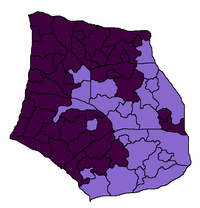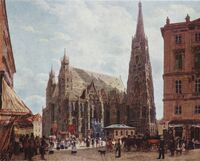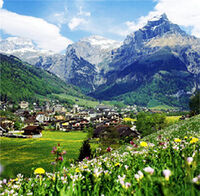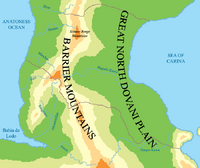
|
Outdated Template In Use! | |
| Please note that the template that you are using is outdated. This may cause issues with the template, the page and the wider Particracy Wiki! Please the current list of supported and up to date templates located here: Templates Manual of Style. If you need assistance please contact Wiki Administrator Auditorii via the in-game forums or Discord. |
| Imperial Crownlands of Hulstria Kaiserlich Kronlander von Hulstria | |
|---|---|
 
Flag Coat of Arms | |
| Motto Das Land und ihr Völker, vereint. | |
| Anthem Land of our Fathers | |

| |
| Capital Karstadt Largest city Karstadt | |
| Languages Hulstrian, Hulstro-Mikun, Kunikata | |
| Denonym Hulstrian or Crownlander | |
| Government Constitutional Monarchy, Totalitarian Dictatorship Head of State Her Imperial Majesty Beatrice II of the House Lasburg Reichskanzler (Imperial Chancellor) Leopold Nimitz | |
| Legislature Reichstag | |
| GDP - Total ₭ 5,633,627,871,137 - Per Capita ₭ 56,547 | |
| Area 855,600 km² | |
| Population 99,627,263 (4125) | |
| Currency Hulstrian Crown | |
| Drives on Left | |
| Internet TLD .hu | |
Hulstria, officially known as the Imperial Crownlands of Hulstria (formerly Mikuni-Hulstria), is a nation on the northwestern coast of Dovani. It is bordered to the north by Kazulia and to the south by Sekowo. To the East lies Ostland and the vast Great North Dovani Plain. It is the 35th most populous nation on Terra with nearly 100 million citizens and the 48th in order of area.
Hulstria is the legal successor state to the Great Reich of Mikuni-Hulstria. It is a constitutional monarchy, with a mixed cultural heritage - although political and cultural moves have been made to make Dundorfian-speaking Hulstrian the prominent culture in the nation. According to scholars, Mikuni-Hulstria can be described as a "neo-Septembrist" successor to the Great Reich, founded following the rehabilitation of Septembrism, although this description itself is politically problematic given the centuries of emnity between Septembrists and the Yukio-Labsburg dynasty that preceded it. Its constitution blends elements of the previous United Imperial Crownlands of Hulstria and Gao-Soto with those established under the House of Yukio-Labsburg.
A significant feature of Hulstria is its royalism, maintained through successive noble houses from the House of Rothingren-Traugott, to the dual monarchy of the Septembrist era and the Yukio-Labsburg Dynasty to the present House of Labsburg.
The terrain in Hulstria is very mountainous due to the presence of the Barrier Mountains, located in the eastern half of the country; in areas such as Budenlar and Kuratha however, lands are relatively flat. The geography of Hulstria has proven to be advantageous against invading forces, especially during the the Hulstrian Rebellion in the 17th century. Mikuni-Hulstria experiences cold weather and longer winters thus making sports like curling and skiing popular.
History of Mikuni-Hulstria[]
Overview[]
| Year | Flag | Name | Government Type |
| 819 – 1560 | Empire of Gao-Soto | Feudal Empire | |
| 1560 – 1650 | Colonial Hulstria | Colony of Luthori | |
| 1650 – 2117 | Empire of Hulstria | Monarchy | |
| 2117-2193 | Great Dark Period | Anarchy | |
| 2193 - 2198 | Republic of Gishoto | Republic | |
| 2198 - 2248 | Holy Gishoto Empire | Constitutional monarchy | |
| 2248 - 2309 | People's Socialist Republic of Gishoto | Communist dictatorship | |
| 2309 - 2375 | Republic of Gishoto | Republic | |
| 2375 - 2426 | Imperial Crownlands of Greater Hulstria | Constitutional monarchy | |
| 2426 - 2484 | Dual Monarchy of Hulstria and Gao-Soto | Dual monarchy | |
| 2484 - 2533 | Republic of Gishoto | Republic | |
| 2533 - 2551 | Hulstrian Union | Republic | |
| 2551 - 3386 | Imperial Crownlands of Greater Hulstria | Constitutional monarchy | |
| 3386 - 3411 | Imperial Crownlands of Hulstria and Gao-Soto | Dual monarchy | |
| 3411-3416 | North Dovani Union | Totalitarian dictatorship | |
| 3416-3789 | United Imperial Crownlands of Hulstria and Gao-Soto | Constitutional dual monarchy | |
| 3789-3902 | Great Reich of Mikuni-Hulstria | Absolute, Feudal Monarchy | |
| 3902-3936 | United Empire of Hulstria and Mikuni | Constitutional dual monarchy | |
| 3936-4017 | Great Reich of Mikuni-Hulstria | Absolute monarchy | |
| 4017-4108 | United Democracy of Mikuni-Hulstria | Democratic Republic | |
| 4108-4168 | Great Reich of Mikuni-Hulstria | Absolute monarchy | |
| 4168-4257 | Imperial Crownlands of Mikuni-Hulstria |
Constitutional monarchy | |
| 4257-present | Imperial Crownlands of Hulstria | Constitutional monarchy, later totalitarian one-party dictatorship |
Government and Politics[]
In constitutional terms, the Imperial Constitution of 4167, which was based on drafts written by Septembrist leader Florian Goddestreu, strongly resembles the institutions of Septembrist Hulstria and Gao-Soto. Despite the absence of a dual monarchy, the representation of the sovereign in politics and as head of state is vested in an elected Governor-General of Mikuni-Hulstria. As regards the monarch, despite being held in high esteem, the constitution stipulates his inviolability and consequently provides that the Governor-General and ministers hold political responsibility, thereby rendering the role of the sovereign largely ceremonial, a large departure from the preceding Great Reich where, to varying degrees, the Imperial sovereignty was absolute.
Legislative power is vested in the bicameral Imperial Assembly, of which the lower house, the Rēkusutagu or Imperial Diet, is the most powerful. The Diet is elected by universal suffrage and gives rise to His Imperial Majesty's Government, led by the State Chancellor, whose role approximates to a large extent the Staatsminister of the Septembrist era (as opposed to the ceremonial Cabinet chairman of the Greater Hulstria era). The State Chancellor is the proper head of government, appointing and dismissing ministers through the Imperial prerogative. The direct link with the confidence of the Diet makes the Mikuni-Hulstrian Crownlander system a parliamentary democracy. The Ranzurado or Landsraad was retained as the upper house, although its noble composition was supplemented by various representatives of local government, and its veto is now merely suspensive.
Administrative Divisions[]
After the Imperial Constitution passed, Mikuni-Hulstria restored the eponymous Crownlands as its major subdivisions, thereby restoring the former "Circles" of the Great Reich to their former title, with all its connotations of being a core constituent of the democratic system. The five Crownlands are Budenlar, Hulstria, Mitrania, Hilgar, and Kuratha; each have their own elected government and unique culture. The Circles are governed by elected Landtags /Syuu Gikai who make up their legislatures and Chief Ministers who head the regional government and supervised by Crown Commissioners appointed by the Monarch.
Circles[]
| Crownland | Flag | Area | Population | Capital |
|---|---|---|---|---|
| Budenlar | 143,100 km² | 19,899,786 | Labsburg | |
| Hilgar | 229,500 km² | 19,952,951 | Miyako | |
| Hulstria | 111,000 km² | 19,961,991 | Kien | |
| Kuratha | 162,300 km² | 19,868,082 | Anderinch | |
| Mitrania | 209,700 km² | 19,889,161 | Syakusen |
Culture[]
For most of its history, Mikuni-Hulstria did not have a single, defining national culture like most nations do. Instead Mikuni-Hulstria had two different cultures that fell around ethnic lines and a third hybrid culture. Throughout most Hulstro-Mikun history, the nation was characterized by the conflict between the Hulstrians and the Gao-Showa with their two very different cultures. Hulstrian culture was by far the most dominant in the nation since the colonial era. However they did have some common ground such as reverence for authority and history and a strong belief in family bonds and values. Ironically the hybrid version of these two cultures, termed by scholars "Gishoton Culture", had very little to do with the common ground the cultures share, but instead taking certain ideas and practices from each and mashing them together. This was largely because most of the people in the nation who adopted Gishoton Culture were members of the extreme left politically, and viewed the common ground that Hulstrian and Gao Showa Cultures shared as too conservative if not reactionary for them.
In time the mixed Gishoton Culture gradually became the dominant culture of the nation. No longer clearly differentiated, due to racial intermixing and cultural exchange, Hulstrians and Gao-Showans no longer existed as separate nations - having merged into a single, shared culture that bore little resemblance to the original colonial settlers or the Empire of Gao-Soto. Now, most of the nation speaks a language known as Hulstro-Mikun, a Dundorfian-based creole language with a strong Gao-Showan influence. Under the rule of the Yukio-Labsburgs a "Hulstro-Showan" identity, evolving out of Gishoton Culture, was promoted officially, and Hulstro-Mikun was introduced as the official language in place of "proper" Dundorfian.
Demographics[]
Ethnicity[]

The Districts of Hulstria by Ethnicity during the Dual Monarchy

The Districts of Hulstria by ethnicity during the Greater Hulstria period

The Districts of Hulstria and Gao-Soto by ethnicity during the Septembrist era
- Hulstro-Showans - 30%
- Hulstrians - 28%
- Kunihito - 26%
- Gisoten (Westernised Kunihito) - 5%
- Draddwyr - 1%
- Istapali - 1%
- Llaqta - 1%
- Welang - 1%
- Others - 4%
The population of Mikuni-Hulstria was traditionally divided into two groups. The Caucasian Hulstrians are the descendants of Luthori and other Artanian colonists to the nation, are largely Hosian/Luthoran, and live mostly in the North and West of the country. The Gao-Showan Kunihito are considered the native population, although they also colonised the nation, roughly one millennium before the Hulstrians. They are mostly followers of the Kamist or Daenist religions and live in the East and South. The division between these groups and the rival claims to ownership of the country has led often to rivalry and war between the two. In time, intermarriage and co-existence led to the emergence of a hybrid culture, known as "Gishoton Culture". During the long-lived Septembrist era Gishoton culture crystallized as a fully distinct ethnic group, the Hulstro-Showans, which was officially recognized under the subsequent regimes.
There are other ethnic groups present in the nation, notably the Draddwyr who came to Mikuni-Hulstria during the Draddwyr Genocide in Dranland, but also Kazulians, Dranians, Sekowans, and Trigunians. Most immigrant populations are quickly subsumed into one of the main ethnic groups.
Religion[]

The Hulstrian National Cathedral, Kien
Stats on Religion of all nationals:
- Irreligious - 38%
- Hosianism - 21%
- Confessional Luthoranism - 14%
- Aurorian Patriarchalism - 7%
- Tenshism - 15%
- Daenism - 11%
- Mazdayana - 5%
- Draddwyr Daenism - 2%
- Kamism - 7%
- Hulstro-Mikun New Religions - 4%
- Morokism - 1%
- Thetanism - 1%
- Aretism - 1%
- Other - 1%
Geography and Climate[]

A view of mountain valley in Hulstria

A physical map of Mikuni-Hulstria and the surrounding region
As a country in the far north of Terra, Mikuni-Hulstria is quite a cool country and during the long winter temperatures are generally below freezing causing impressive snow storms. During the summer however the climate is pleasant with the south of the country often becoming quite warm due to the ocean currents bringing warm water up from the equator.
Mikuni-Hulstria is a fairly mountainous nation because of its location on the Schnee-Berge Mountain range. The coastal Crownlands of Budenlar and Kuratha are quite flat with the land slowly rising from the coast into the rolling hills of the interior. Further inland the Crownlands of Hulstria and Mitrania are dominated by picturesque snow-capped mountains. Most cities are in the foothills to the west of the crownlands with the east being dominated by the Schnee-Berge Mountains, too steep in many cases to build on or farm. Much of the Crownland of Hilgar lies on the other side of the barrier mountains and it flattens out into the Great North Dovani Plain, which makes up the bulk of the Eastern Territories and the north of Carina.
Economy[]

The Marchau Mercantile Exchange
Mikuni-Hulstria is a heavily industrialised nation with much of the population living in major conurbations. Following independence after the Great Rebellion and the creation of the First Hulstrian Empire industrialisation was rapid with the economy switching from a mainly subsistence agricultural society to one based on the production of metals from the nation's abundant ores in the mountains. Hulstria also has a huge steel and aluminium industry and also produces copper and gold.
Hulstria is one of the leading producer of ocean going vessels in the world. With her historic origins as a colony, ships were vital to getting back to Luthori and the Hulstrians became experts in this field as a result. When the age of steel ships dawned, Hulstria led the way using her vast iron and coal deposits as well as rapid industrialization to produce high quality capital ships. Today Hulstria continues her dominance of the shipping industry, with several of the worlds largest drydocks, shipyards, and ports located in the Imperial Crownlands.
The abundance of metals also allowed the nation to build up an impressive automobile industry. Hulstria is a large producer of many forms of transportation with major shipyards on the coast of Budenlar and companies producing passenger and military aircraft. Most companies in Hulstria are part of massive conglomerations of industrial and financial interests, which are generally under the control of the major aristocratic families. Despite this apparent dominance of privately controlled companies the country is home to the two major exchanges of Dovani, The Kien Stock Exchange (KSE) and the Marchau Mercantile Exchange (MME), which mainly trade in commodities. The stock exchanges in Mikuni-Hulstria have traditionally been unregulated by the central government.
In modern times Mikuni-Hulstria has emerged as the commanding economic force on the continent of Dovani with the Hulstrian Royal Crown (Hulsterreichischer Krone - ₭), the currency of Hulstria, as one of the most valued on Dovani and has one of the highest GDPs on the continent as well; Hulstria has seen consisent GDP growth with today the Gross Domestic Product just shy of 20 trillion crowns. The Imperial Crownlands since 2551 has maintained a conservative capitalist economy. However most consider the economic system of Hulstria to be that of mixed, taking into consideration current Hulstrian law that has both free and command market policies. Mikuni-Hulstria highly values international trade and has several free market cooperation agreements with nations around Terra. Luthori has been a consistent trading parter of Hulstria as has been Drania, Kazulia, Kirlawa, and others.
Military[]

Hulstrian Phoenix III Tank
Mikuni-Hulstria's military consists of these main branches; the Armed Forces, Imperial Navy, Imperial Air Corps, the Imperial Marines, and the Imperial Guard. The Imperial Marine Corps is the oldest military branch of Mikuni-Hulstria as it was founded in the 1640s by Franz I of Hulstria during the Hulstrian Rebellion from Luthori; the Imperial Guard, while considered a military branch, is the personal protection force of the Emperor of Hulstria, who is formally the Supreme Commander of the Hulstrian Imperial Army though delegates most power to the Ministry of Defense during peacetime. The Hulstrian Ministry of Defense has policy control over the military and supervising power of the the activity of its subordinate agencies though the Imperial Diet, Hulstria's legislature, has the power to declare war, and to institute other reforms as well within that Ministry; each branch has a Field Marshall (or Air Marshal, Admiral etc, depending on the branch) and their own chain of command. Other parts of the military include the Civil Defense Service, subordinate to the Ministry of Defense, and the Imperial Reserves, the reserve branch of the Hulstrian military.
Mikuni-Hulstria has a long history of taking part and taking lead naval activites. Following Hulstria's independence, several monarchs of the original Rothingren line fron Franz I, before unification with the House of Traugott after the War of the Hulstrian Succession, began pushing for rapid increase of construction of military ships, and shipyards. Budenlar and Kuratha, the two Crownlands with a coast, have dozens of submarine and naval bases along their coast; Budenlar traditionally has held the title of the "ship building capital" of Mikuni-Hulstria. Luthori and Dundort construction skills were adapted in colonial Hulstria and through out the nation's history, Hulstrian ship architects have formed their own unique tools of the trade concerning ship construction.
Landmarks Of Mikuni-Hulstria[]
Mikuni-Hulstria is a nation legendary and internationally acclaimed for its many landmarks. Due to the nation's history and its infusion of both Hulstrian and Gao-Showa cultures, many unique structures dot its landscape. Equally impressive is the landscape itself. Hulstria stretches from the beautiful beaches of Luthorische Bai and Marchau to the rolling hills of Rothingren and Graaffsberg and all the way up into the scenic mountains surrounding the capital of Kien. Hulstria is, of course, most known for its Imperial history and castles and palaces, like Fliederbrunn Palace, are popular for tourists to visit, while others like, Phönixstein Castle, are famed landmarks even though they are not open to the public.





